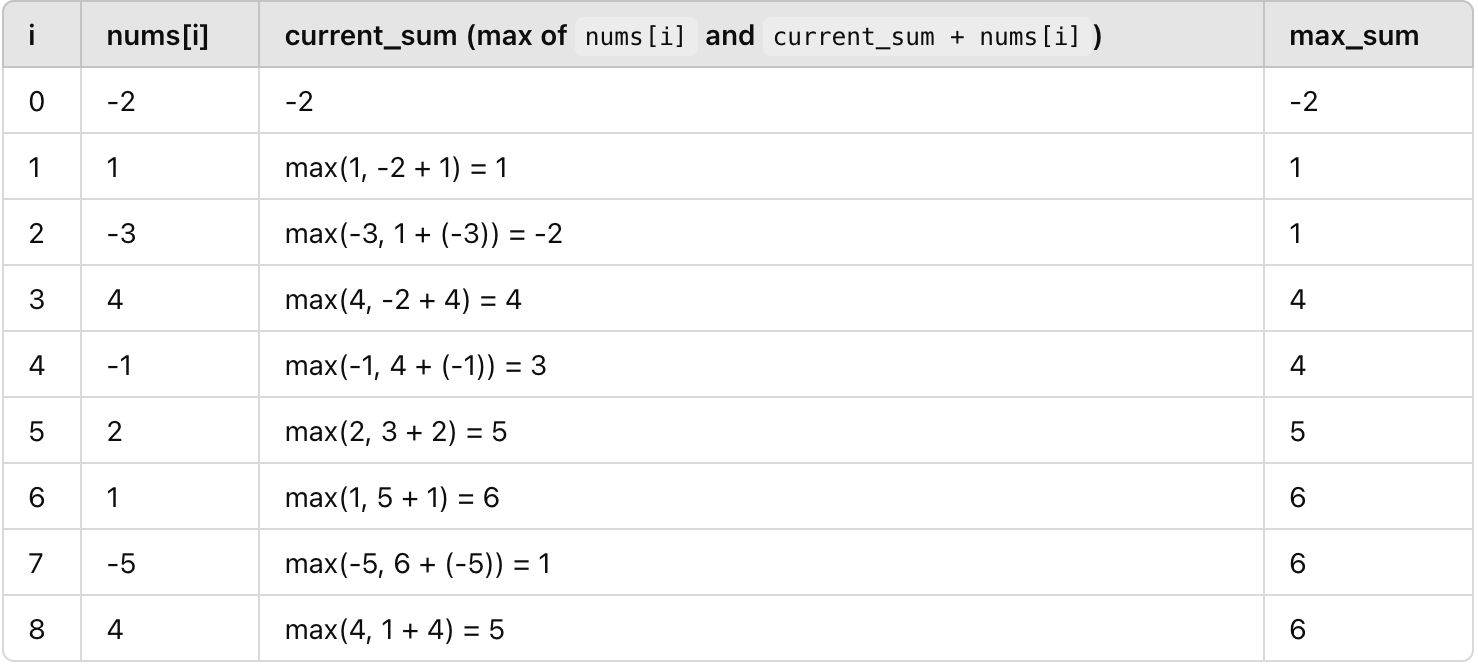Maximum Subarray
Given an integer array nums, find the subarray with the largest sum, and return its sum.
Problem Statement
LeetCode-53: Given an integer array nums, find the sub-array with the largest sum, and return its sum.
Input: nums = [-2,1,-3,4,-1,2,1,-5,4]
Output: 6
Explanation: The subarray [4,-1,2,1] has the largest sum 6.
Input: nums = [1]
Output: 1
Explanation: The subarray [1] has the largest sum 1.
Input: nums = [5,4,-1,7,8]
Output: 23
Explanation: The subarray [5,4,-1,7,8] has the largest sum 23.
Approach
We can use Kadane’s algorithm to solve this problem. The algorithm is based on the following idea:
- We traverse the array while maintaining a local sum
currentSumfor the maximum subarray ending at each index. - At each step, we decide whether to extend the existing subarray or start fresh from the current element.
The decision to extend the existing array or not is done by comparing the current element with the sum of the current element and the previous subarray i.e. $currentSum=max(nums[i],currentSum+nums[i])$
If currentSum+nums[i] is greater than nums[i], it means extending the current subarray is beneficial. On the other hand nums[i] itself is larger, then the previous subarray’s sum is hurting the result, so we start fresh. Additionally,the algorithm keeps track of the maximum sum encountered so far.
Consider the example: [-2,1,-3,4,-1,2,1,-5,4]

Here is the step-by-step approach to solve the problem:
- Initialize two variables
maxSumandcurrentSumtonums[0]. - Iterate over the array starting from index
1. - For each element
numin the array:- Update
currentSumto the maximum ofnumandcurrentSum + num. - Update
maxSumto the maximum ofmaxSumandcurrentSum. - Continue the iteration.
- Update
- Return
maxSum.
This also handles an edge case where all the elements in the array are negative. In this case, the algorithm will return the maximum element in the array.
Implementation
Here is a Java implementation of the above approach:
public int maxSubArray(int[] nums) {
int maxSum = nums[0];
int currentSum = nums[0];
for(int i=1; i < nums.length; i++){
int elem = nums[i];
currentSum = Math.max(elem, currentSum + elem);
maxSum = Math.max(maxSum, currentSum);
}
return maxSum;
}
Complexity Analysis
The time complexity for this approach is $O(n)$, where $n$ is the length of the input array nums. The space complexity is $O(1)$ since we use only a constant amount of extra space.